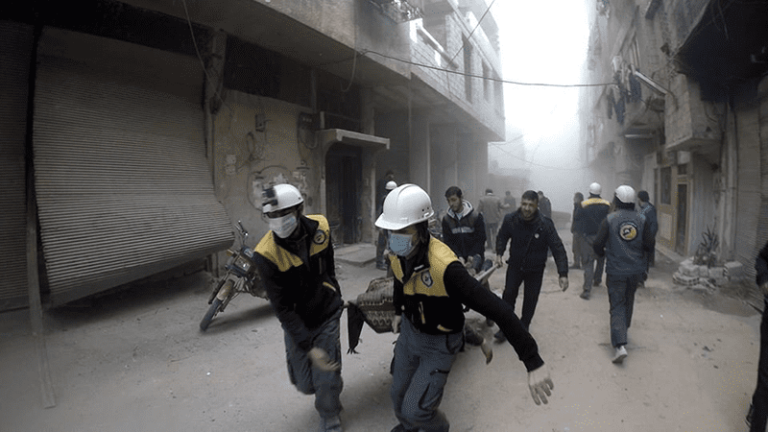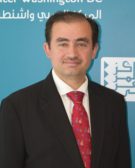
Eastern Ghouta, with an area of about 100 square kilometers and a population of over 400,000, is witnessing unimpeded destruction at the hands of the Syrian regime with Russia’s political and military backing. The people of this district near Damascus are being exposed to relentless aerial bombing and ground attacks that have killed over 500 civilians, including many children. Syrian President Bashar al-Assad’s regime has used barrel bombs, artillery shells, and internationally prohibited munitions like napalm, cluster bombs, and chemical weapons in its assault. The area has been under siege for over five years and the regime continually confiscates whatever provisions are sent by the United Nations and humanitarian organizations. Indeed, its fate may resemble that of Western Ghouta, which suffered from siege and destruction for four years until the Syrian opposition and the government reached an agreement, according to which the area’s inhabitants were made to leave their homes and flee to the north of the country in the largest forced eviction in the country’s modern history.
Eastern Ghouta: The Five-Year Siege
While the siege of Sarajevo lasted almost four years (April 1992-February 1995), the current siege of Eastern Ghouta began in March 2013, now almost surpassing the five-year mark. A United Nations report in 2014 described it as follows:
Eastern Ghouta has thwarted Assad’s dream of controlling “Useful Syria.”
As of March 2013, Government forces began to tighten the siege around Ghouta and intensified shelling and aerial bombardments of the densely populated area. Since then, Government forces have reportedly prevented civilians and humanitarian convoys from crossing into the besieged areas. Field hospitals, medical points, power generators and water tanks in Rural Damascus, including in the districts of Duma, Zamalka, Kafar Batna, ‘Erbin, Darayya and al-Muadhamiya, were damaged or destroyed as a result of government shelling.
The UN Human Rights Council’s independent investigative commission, based in Geneva, issued a report in August 2014 about the Syrian government’s practices in the area. It stated that, “Government forces have committed gross violations of human rights and the war crimes of murder, hostage-taking, torture, rape and sexual violence, recruiting and using children in hostilities and targeting civilians. Indiscriminate and disproportionate aerial bombardment and shelling led to mass civilian casualties and spread terror. Government forces used chlorine gas, an illegal weapon.”
In December 2017, UN experts published an analysis, based on satellite imagery, identifying “approximately 3,853 destroyed, 5,141 severely damaged and 3,547 moderately damaged buildings in the more densely-populated western parts of the enclave.” In addition, in Ain Tarna, the suburb “where between 17,000 and 20,000 civilians are believed to live, 71 percent of structures are damaged or destroyed, according to the analysis. In neighboring Jobar, where only rebels remain, the figure is 91 percent.”
Eastern Ghouta was also victim, in August 2013, to one of the worst chemical attacks against civilians, which led to the death of more than 1,400 people, many of whom were children. The report by the investigative commission into this sarin chemical attack describes it in detail as coordinated and planned. It states that four missiles were launched in the middle of the night as everyone was asleep to maximize the number of those killed. And since the area was under siege, people and medical facilities were ill-prepared to respond to the attack.
The assault on Eastern Ghouta is Russia’s response to the failure of the Sochi conference.
Nevertheless, and despite the international outcry following the 2013 sarin attack and President Barack Obama’s threat against crossing a red line on the use of chemical weapons, Eastern Ghouta remained under siege and supplies of food and medicine were not allowed to enter—this is despite UN Security Council resolutions regarding the use of chemical weapons and others, such as Resolution 2268 of February 26, 2016, which specifically addresses sieges and humanitarian intervention.
Assad’s Continuing Failure
Eastern Ghouta remains a serious trouble spot for the Assad regime. It is only kilometers away from central Damascus and, since the start of the Syrian uprising, has been a center of opposition activity. Since then, it has thwarted Assad’s dream of controlling what he later deemed “useful Syria”—areas in northern and western Syria that carry strategic importance. It thus was constantly exposed to the use of prohibited weapons and indiscriminate bombing by air and ground assets against civilian targets.
The United Nations continues to fail to deliver humanitarian supplies to Eastern Ghouta during the current siege. The regime, however, has not been able to conquer the area in spite of resorting to indiscriminate shelling that has transformed the area into rubble, just as what happened to Western Ghouta, Daraya, and the cities of Aleppo and Homs.
Russia’s Solution in Ghouta and America’s Weakness
Sergei Lavrov declared that the latest ceasefire did not apply to what he called terrorist organizations in Ghouta.
It is hard to see the assault on Eastern Ghouta as anything but a response to the failure to convene a successful conference in Sochi, Russia, last January. Then, Russia failed to secure the participation of the Syrian opposition or its acceptance of the conference’s meager outcome of forming a committee to write the constitution. By supporting the Syrian regime’s assault on Ghouta, Russia has broken its commitment to be a guarantor of the de-escalation zones that were agreed to at Astana, Kazakhstan. Russia also ignored the international outcry and calls for a ceasefire, delaying UN Security Council resolutions about the issue so that the regime could finish implementing its designs for the area. This has prompted the international community to exert pressure on Moscow, especially at the Security Council. Finally, the world body unanimously approved Resolution 2401 on February 24, which demanded the immediate lifting of the siege on Eastern Ghouta and other areas of the country, permitting humanitarian organizations to assist civilians and implementing a comprehensive ceasefire.
Still, on the second day of the resolution, the Syrian regime used chlorine gas against the area, killing 33 civilians. From his side, Russian Foreign Minister Sergei Lavrov declared that the ceasefire did not apply to what he called terrorist organizations in Ghouta, in the process justifying the regime’s military operations. He also stated that the ceasefire would last for only a few hours, and asked civilians to leave the area—just like what happened during the siege of Aleppo in 2016.
The United States has finally, and completely, become a mere observer.
Since the beginning of the latest assault on Ghouta, Russia has been able to delay Security Council deliberations and actions. It has also succeeded in eliminating any language criticizing the Assad regime. In fact, a draft resolution sponsored by Kuwait and Sweden that spoke of an “immediate” ceasefire was changed to state “without delay,” so that the regime would have time to finish its mission. Still, despite the watered-down version of the resolution, there is no guarantee that the regime will implement it, as previous occasions have shown. It is indeed assumed that once international pressure subsides, the regime, supported by Russian forces, will resume its attempts at controlling the area militarily.
What helps this Russian position and onslaught on Eastern Ghouta, which has turned into a “hell on earth,” is the absence of a clear American stance on what happens in Syria. The United States has finally, and completely, pivoted to acting as a mere observer with no choices, such as military action, to prevent the Syrian air force from targeting civilians in Eastern Ghouta. The regime that has not been deterred from using chemical weapons before is unlikely to have qualms about crossing prohibited lines since its first and foremost goal is to remain in power.
This is why the United States is called upon to go beyond rhetorical exhortations at the UN Security Council and elsewhere and to offer more than emotional expressions of sympathy for Syrian civilians. It would be wise to consider using whatever means necessary, including military force, to protect and defend civilian life in Syria and to work on a political solution to that country’s war based on a transition from authoritarian rule.

